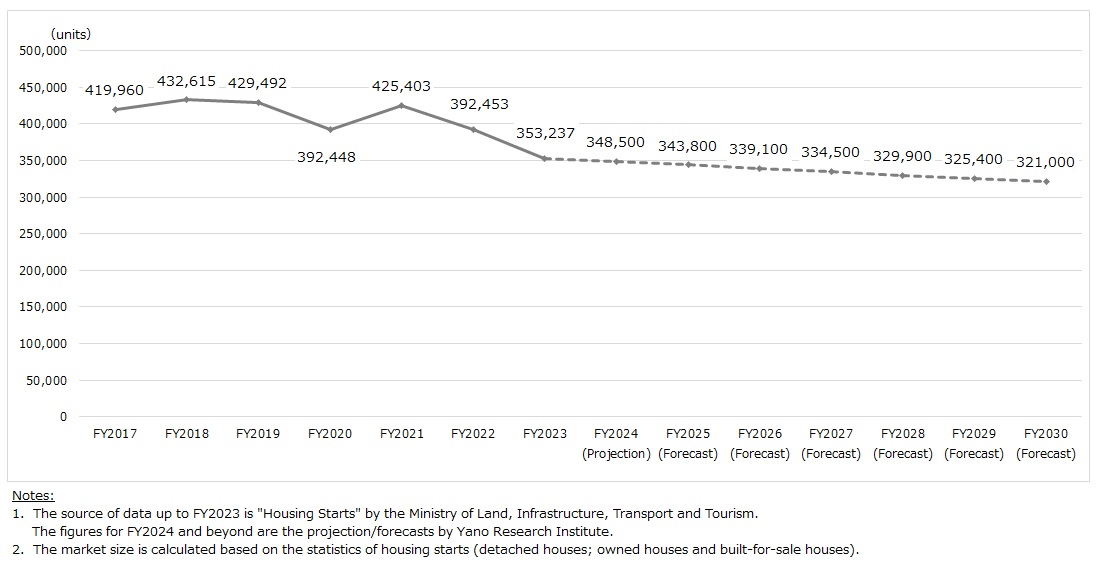No.3798
Detached House Market in Japan: Key Research Findings 2025
Housing Starts of Detached Houses Forecasted to Decline to 321,000 by FY2030, Down 10% From FY2023
Yano Research Institute (the President, Takashi Mizukoshi) has conducted a survey on the domestic detached housing market and found out the current status and future perspectives. This press release denotes our forecast on the housing starts.

Market Overview
Since FY2018, the domestic market for newly built detached houses has been on a downward trend, largely due to structural challenges such as a declining population and sharply rising housing prices driven by escalating construction costs. Despite these unfavorable market conditions, the segment for built-for-sale detached houses has remained relatively resilient. Amid increasing housing prices, demand for affordable built-for-sale houses, such as those build by “power builders” (house builders that specialize in reasonable built-for-sale housing), has been growing steadily.
In response to the demand, even major house makers that traditionally focused on custom-built homes have recently begun to strengthen their presence in the built-for-sale market in the last few years. This shift also owes to the fact that built-for-sale housing is relatively more profitable than custom-built homes, as it generally requires less time and cost for sales and design.
Noteworthy Topics
“House Makers” Offering A Wide Range of Homes
In recent years, the Japanese government has shifted the focus of the Basic Housing Policy from increasing the number of houses to improving housing quality. At the same time, consumer preferences and demands have become increasingly diverse. In response to these evolving trends, house makers* have expanded their product portfolios to offer a wide range of housing options that cater to varying lifestyles and needs.
One such offerings is eco-friendly housing. Amid increasing societal emphasis on ecologically sound lifestyle, house makers are actively developing sustainable housing like Net Zero Energy Homes (ZEH, which aim to reduce energy consumption and environmental impact).
Additionally, to enhance consumer confidence in the face of soaring housing prices, house makers are placing greater emphasis on “standardized (semi-order) housing” as a cost-effective yet high-quality alternative.
This type of housing is positioned between custom-built and ready-built homes. Although choices for floor layouts are restricted, the quality of materials used are similar to those found in fully bespoke homes. The simplified design process contributes to lowering costs, making these standardized homes more budget-friendly while maintaining high quality.
*House makers: Large home builders that operate across Japan with annual closings of over 300.
Future Outlook
The housing starts of detached houses are forecasted to drop to 321,000 by FY2030, which is 90% of the FY2023 level. This downward trend is driven by demographic decline, which is compounded by headwinds such as increasing construction costs and mortgage rates.
Research Outline
2.Research Object: House builders of detached house (“house maker”, “builder”, and “local builder”*) *Note: In Japan, large home builders that operate across the nation with annual closings of over 300 are called “house makers”. Mid-sized builders that are region-based with around 20 closings per year are called “builders”. House builders smaller than “builders” are called “local builders (ko-mu-ten)”.
3.Research Methogology: Face-to-face interviews by our expert researchers (including online interviews), corporate questionnaire, and literature research
What is the Detached House Market?
In this research, the detached house market encompasses the market of newly built detached houses (full custom orders, built-for-sale, and rebuilds of existing homes) and the market of pre-owned detached houses.
<Products and Services in the Market>
New detached houses (full custom orders, built-for-sale, and rebuilds of existing homes) and pre-owned detached houses
Published Report
Contact Us
The copyright and all other rights pertaining to this report belong to Yano Research Institute.
Please contact our PR team when quoting the report contents for the purpose other than media coverage.
Depending on the purpose of using our report, we may ask you to present your sentences for confirmation beforehand.